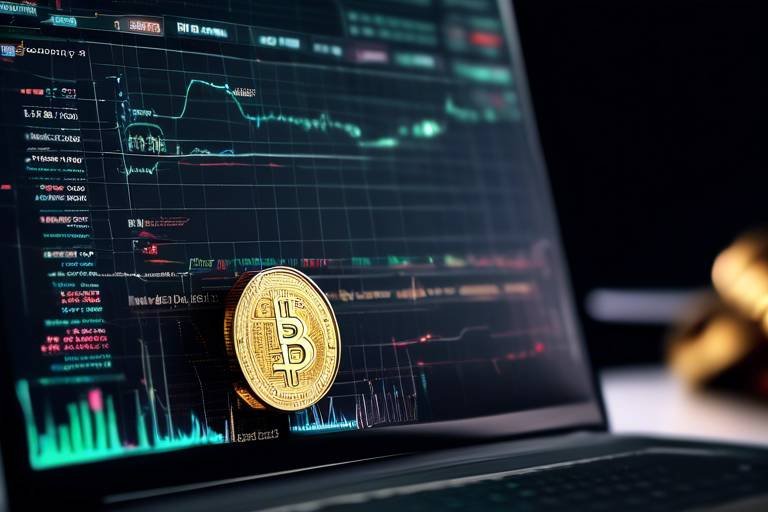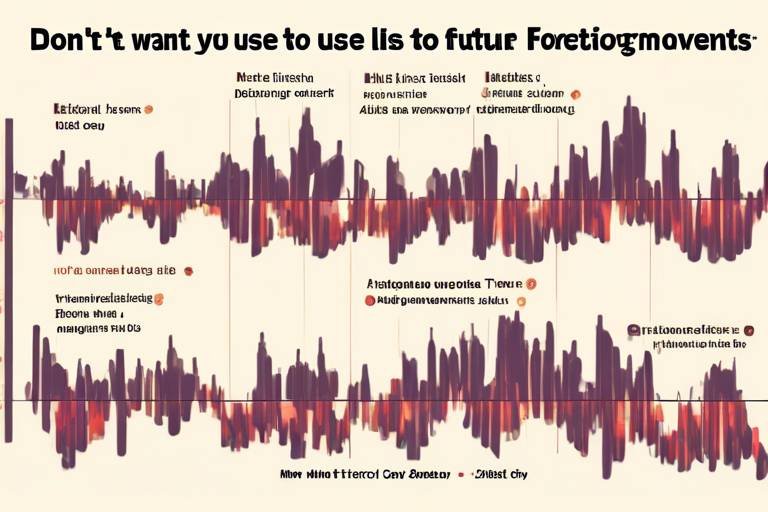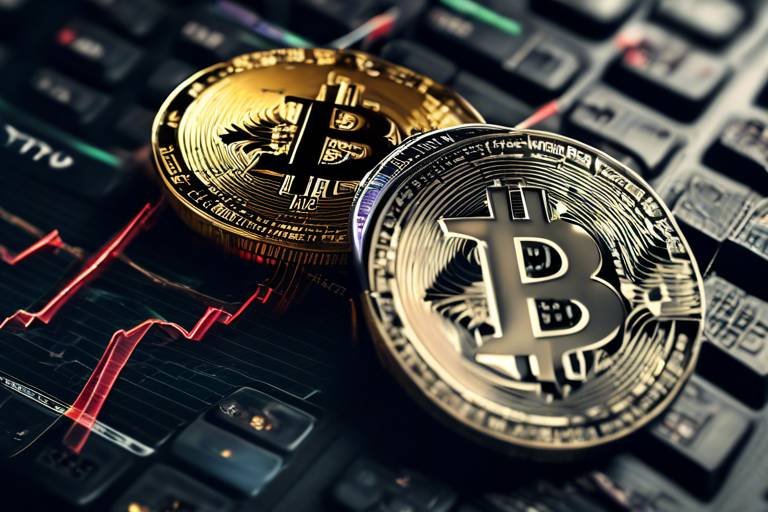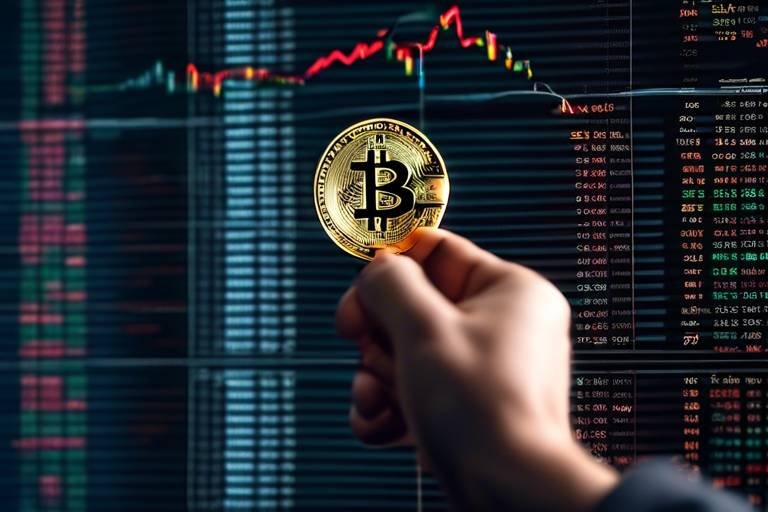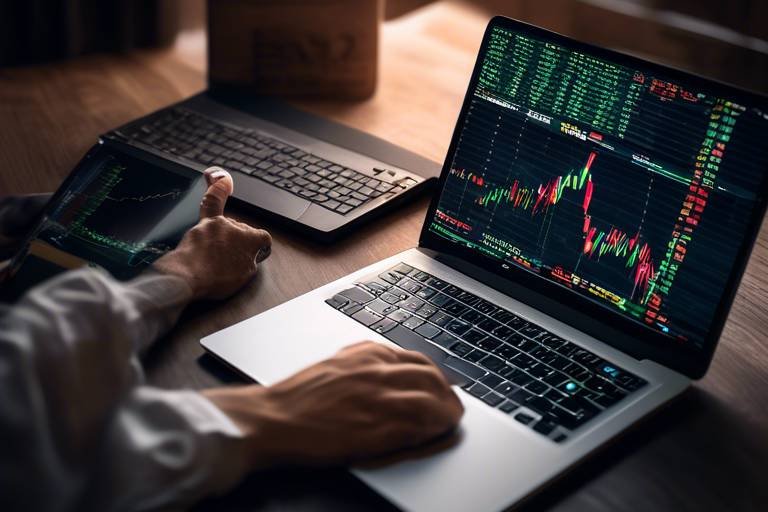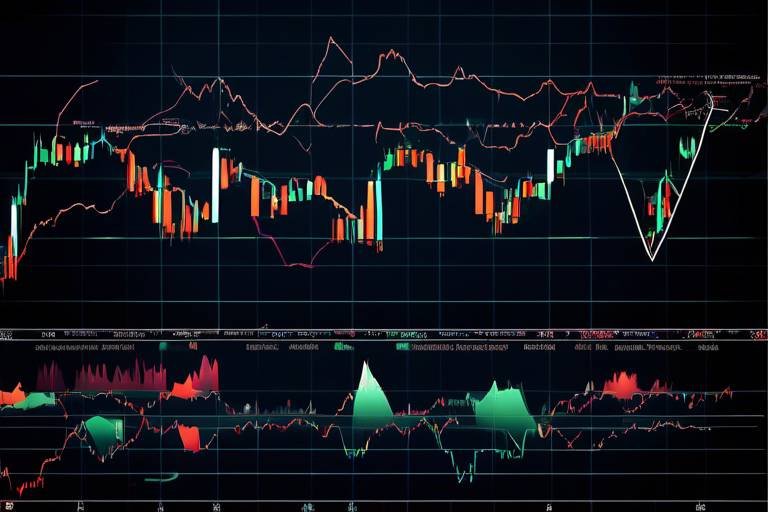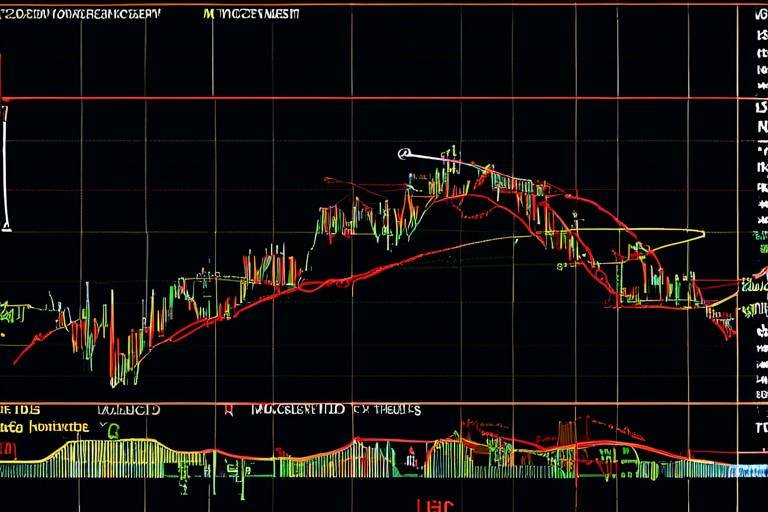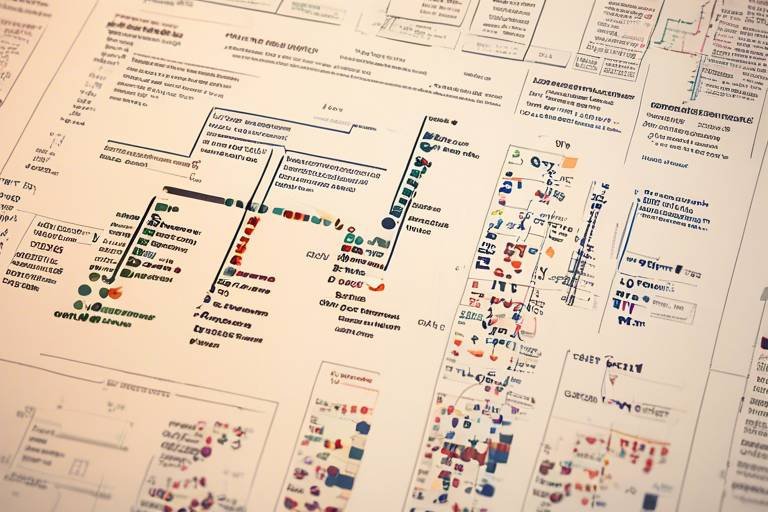Understanding the Basics of High-Frequency Trading in Crypto
High-frequency trading (HFT) has emerged as a significant player in the world of cryptocurrency, transforming how traders engage with the market. But what exactly is HFT? In simple terms, it's a method that utilizes advanced algorithms and lightning-fast data networks to execute a vast number of orders in mere fractions of a second. Imagine being able to buy and sell assets faster than the blink of an eye! This rapid trading capitalizes on tiny price movements that occur in the ever-fluctuating crypto market.
As we delve deeper into this fascinating topic, it's essential to understand that HFT isn't just about speed. It’s also about the sophisticated technology and strategies that underpin this trading style. Traders deploying HFT strategies can react almost instantaneously to market fluctuations, making it possible to seize opportunities that traditional traders might miss. This capability is akin to having a superpower in the trading world, allowing for a level of responsiveness that can significantly enhance profitability.
Now, you might be wondering, why should anyone care about high-frequency trading? Well, the impact of HFT extends beyond individual traders. It plays a crucial role in the overall market dynamics by providing liquidity, which is essential for a healthy trading environment. When traders can quickly buy and sell assets, it stabilizes prices and reduces volatility, creating a more efficient market for everyone involved.
However, it's not all sunshine and rainbows. The world of high-frequency trading is fraught with challenges and risks. Issues like market manipulation, technological failures, and regulatory scrutiny can pose significant threats not only to traders but also to the broader market. As we navigate through the intricacies of HFT, it becomes clear that while the potential rewards are enticing, the pitfalls can be equally daunting.
In this article, we will explore the fundamentals of high-frequency trading in the cryptocurrency market, dissect its mechanisms, weigh its advantages against its challenges, and discuss its impact on market dynamics. By the end of our journey, you’ll have a clearer understanding of whether HFT is a strategy worth considering in your trading endeavors.
- What is high-frequency trading? High-frequency trading refers to the use of algorithms to execute trades at incredibly high speeds, capitalizing on small price movements.
- How does HFT impact market liquidity? HFT provides liquidity by quickly matching buy and sell orders, which helps stabilize prices and reduce volatility.
- What are the risks associated with HFT? Risks include market manipulation, technological failures, and regulatory scrutiny, which can affect both traders and the market as a whole.
- Is HFT suitable for all traders? HFT is generally more suited for institutional traders due to the need for advanced technology and significant capital investment.

What is High-Frequency Trading?
High-frequency trading, often abbreviated as HFT, is a sophisticated trading strategy that leverages advanced technology and algorithms to execute a massive number of orders at lightning speed. Imagine a race car zooming around a track, where every second counts. In the world of finance, especially in the cryptocurrency market, this is the essence of high-frequency trading. The goal is to capitalize on tiny price movements that occur within fractions of a second, making it possible for traders to profit from even the slightest fluctuations in market prices.
At its core, HFT relies on a few critical components that work in harmony to create a seamless trading experience. These include:
- Advanced Algorithms: These are mathematical models designed to analyze market data and execute trades based on predefined criteria.
- High-Speed Connectivity: This ensures that data is transmitted and received without delay, allowing traders to make split-second decisions.
- Data Analysis: HFT traders utilize real-time data feeds to monitor market conditions, enabling them to react quickly to changes.
In essence, high-frequency trading is not just about speed; it's about precision and efficiency. Traders use complex algorithms to identify patterns and make predictions about market movements, often executing thousands of trades in the blink of an eye. This method of trading has revolutionized the cryptocurrency landscape, introducing a level of competition and liquidity that was previously unseen.
However, while HFT can lead to considerable profits, it also presents unique challenges and risks. The technology that enables these rapid trades is incredibly complex, and even a minor glitch can lead to significant financial losses. Moreover, the sheer volume of trades can sometimes lead to market volatility, raising concerns among regulators and traditional investors alike.
In summary, high-frequency trading is a cutting-edge approach to trading that combines speed, technology, and sophisticated strategies to capitalize on fleeting opportunities in the market. As the cryptocurrency space continues to evolve, HFT will undoubtedly play a pivotal role in shaping its future.

Key Components of HFT
High-frequency trading (HFT) in the cryptocurrency market is a complex ecosystem characterized by several key components that work in harmony to facilitate rapid trading decisions. At the heart of HFT lies advanced technology, which includes powerful computers and sophisticated algorithms designed to analyze market data at lightning speed. This technology allows traders to execute a large number of orders in mere fractions of a second, capitalizing on even the tiniest price movements that occur in the volatile crypto landscape.
Another critical element of HFT is algorithmic strategies. These strategies involve predefined rules and mathematical models that guide trading decisions. Think of them as the brain behind the operation, enabling traders to react swiftly to market changes without the emotional biases that often cloud human judgment. By employing these algorithms, traders can optimize their outcomes, ensuring they are always a step ahead in an ever-changing market.
Moreover, high-speed connectivity is a vital component of HFT. The ability to transmit and receive data almost instantaneously can make all the difference in executing trades before the competition. This connectivity is often achieved through co-location services, where traders place their servers in close proximity to exchange servers. This arrangement minimizes latency, allowing for quicker order execution and giving traders a significant edge over those who operate from farther away.
In summary, the key components of high-frequency trading—advanced technology, algorithmic strategies, and high-speed connectivity—work together to create a dynamic trading environment. Each element plays a crucial role in ensuring that traders can make rapid decisions and execute orders with precision. As the cryptocurrency market continues to evolve, these components will undoubtedly adapt, pushing the boundaries of what HFT can achieve.
- What is the primary goal of high-frequency trading?
The primary goal of HFT is to capitalize on small price movements in the market by executing a large number of trades in a very short time frame. - How do algorithmic strategies work in HFT?
Algorithmic strategies use predefined rules and mathematical models to guide trading decisions, allowing traders to react quickly to market changes. - What are the risks associated with high-frequency trading?
Risks include market manipulation, technological failures, and regulatory scrutiny, which can affect both traders and the broader market. - How does HFT enhance market efficiency?
By executing trades rapidly based on real-time data, HFT helps ensure accurate pricing and quicker adjustments to new information in the market.

Algorithmic Trading Strategies
When you think about high-frequency trading (HFT), it's like watching a high-speed race where every millisecond counts. are the engines that power this race, allowing traders to make rapid decisions based on complex mathematical models and predefined rules. These strategies are designed to capitalize on fleeting market opportunities that can disappear in the blink of an eye. Imagine trying to catch a butterfly; if you’re too slow, it flits away. In the world of crypto trading, that butterfly is a tiny price movement, and algorithmic strategies are your net.
At the heart of these strategies lies the ability to analyze vast amounts of data in real-time. Traders deploy algorithms that can process information from various sources—news articles, social media sentiment, and price charts—within fractions of a second. This allows them to react swiftly to market changes that would be impossible for a human trader to manage manually. The algorithms execute trades automatically when certain conditions are met, ensuring that traders can take advantage of price discrepancies without delay.
Some common types of algorithmic trading strategies include:
- Trend Following: This strategy aims to identify and capitalize on upward or downward trends in the market. By analyzing historical data, algorithms can predict future price movements and execute trades accordingly.
- Mean Reversion: Here, the algorithm identifies when a cryptocurrency's price deviates significantly from its historical average, betting on the price returning to that average.
- Statistical Arbitrage: This involves using statistical models to identify correlations between different cryptocurrencies or markets, allowing traders to exploit price inefficiencies.
Each of these strategies requires a solid understanding of market dynamics and the underlying technology. For instance, trend following can be likened to surfing; you need to catch the right wave at just the right moment. If you miss it, you might wipe out. Similarly, mean reversion is about knowing when to jump back into the water when it’s calm again.
Moreover, the effectiveness of these strategies often hinges on the quality of the data and the speed of execution. Traders invest in low-latency networks and co-location services to ensure that their algorithms can operate with minimal delay, giving them a competitive edge. In essence, the faster you can process data and execute trades, the better your chances of success in this frenetic environment.
As we look to the future, the evolution of algorithmic trading strategies continues to be influenced by advancements in machine learning and artificial intelligence. These technologies enable algorithms to learn from past trades, adapt to changing market conditions, and improve their decision-making processes. Picture a chef refining their recipe over time; the more they cook, the better the dish becomes. In the same way, algorithms can become more effective as they learn from their trading experiences.
In conclusion, algorithmic trading strategies are the backbone of high-frequency trading in the cryptocurrency market. They allow traders to navigate the complexities of the market with precision and speed, making them indispensable tools for anyone looking to thrive in this fast-paced environment.
- What is the main advantage of algorithmic trading? The main advantage is speed; algorithms can execute trades much faster than humans, allowing traders to capitalize on market opportunities that last only seconds.
- Are algorithmic trading strategies suitable for beginners? While they can be beneficial, they often require a deep understanding of market dynamics and technology, making them more suitable for experienced traders.
- What risks are associated with algorithmic trading? Risks include technical failures, market volatility, and potential regulatory scrutiny, which can lead to significant financial losses if not managed properly.

Market Making
Market making is a fascinating and essential strategy in the realm of high-frequency trading (HFT), especially within the fast-paced cryptocurrency market. Essentially, market makers are like the lifeblood of trading platforms. They provide liquidity by continuously offering to buy and sell assets, ensuring that there are always orders available for traders looking to enter or exit positions. Imagine a bustling marketplace where vendors are always ready to trade; this is the role that market makers play in the digital currency ecosystem.
One of the primary ways market makers profit is through the spread, which is the difference between the buying price (bid) and the selling price (ask). By placing buy orders slightly below the market price and sell orders slightly above it, market makers can capitalize on these small price differences. This strategy not only generates profit for the market makers but also contributes to a more stable and efficient market. Here’s a simple illustration:
| Order Type | Price |
|---|---|
| Buy Order (Bid) | $100 |
| Sell Order (Ask) | $102 |
In this example, the market maker would earn a profit of $2 for each transaction completed. The more transactions they facilitate, the more they can accumulate profits. However, it's important to note that market making isn't without its risks. In a volatile market, prices can swing dramatically, and if a market maker is caught on the wrong side of a trade, they can incur significant losses.
Moreover, market makers often utilize sophisticated algorithms to manage their orders effectively. These algorithms can analyze vast amounts of data in real-time, allowing market makers to adjust their strategies based on market conditions. For instance, if a particular cryptocurrency suddenly gains popularity, the algorithms can quickly adjust the bid and ask prices to reflect the new demand, ensuring that the market maker stays competitive.
In summary, market making is a vital aspect of high-frequency trading that helps maintain liquidity and efficiency in the cryptocurrency market. By providing a continuous flow of buy and sell orders, market makers not only create opportunities for profit but also foster a healthier trading environment for all participants.
- What is the role of a market maker? Market makers provide liquidity by continuously buying and selling assets, ensuring that there are always orders available for traders.
- How do market makers profit? They profit from the spread between the buying price (bid) and the selling price (ask).
- Are there risks associated with market making? Yes, market makers face risks, especially in volatile markets where prices can change rapidly, leading to potential losses.
- What technology do market makers use? Market makers often use sophisticated algorithms to analyze market data and manage their orders effectively.

Arbitrage Opportunities
Arbitrage opportunities in the cryptocurrency market are like hidden treasures waiting to be discovered. Imagine walking through a bustling market and noticing that the price of a rare collectible varies from one stall to another. This phenomenon is precisely what arbitrage traders capitalize on, but instead of collectibles, they focus on digital currencies. In the world of high-frequency trading (HFT), these price discrepancies can occur within seconds across different exchanges, providing savvy traders with a chance to make profits by executing simultaneous buy and sell orders.
To illustrate this concept, let’s say Bitcoin is trading at $50,000 on Exchange A and $50,200 on Exchange B. A high-frequency trader could buy Bitcoin on Exchange A and sell it on Exchange B almost instantaneously, pocketing the $200 difference. This rapid execution is crucial, as these opportunities often disappear in the blink of an eye.
Arbitrage can be categorized into several types, including:
- Spatial Arbitrage: This occurs when the same asset is priced differently across various exchanges.
- Statistical Arbitrage: This strategy involves using statistical models to identify price discrepancies based on historical data.
- Triangular Arbitrage: This involves trading between three different currencies to exploit price differences.
However, while the allure of arbitrage is strong, it’s essential to recognize the challenges that come with it. High-frequency traders must have access to advanced technology and low-latency networks to ensure their trades are executed faster than others. Even a slight delay can mean the difference between profit and loss. Additionally, transaction fees can eat into potential profits, making it crucial for traders to factor these costs into their strategies.
Despite these challenges, arbitrage trading remains a vital component of the cryptocurrency ecosystem. By exploiting price inefficiencies, these traders not only enhance their own portfolios but also contribute to overall market efficiency. As they buy low and sell high, they help align prices across platforms, ultimately benefiting all market participants.
- What is arbitrage trading? Arbitrage trading involves buying and selling the same asset in different markets to profit from price discrepancies.
- Is arbitrage trading in cryptocurrency risky? Yes, while it can be profitable, it comes with risks such as market volatility, transaction fees, and execution delays.
- How can I start arbitrage trading? To start arbitrage trading, you need to choose reliable exchanges, have a solid understanding of the market, and access to fast trading technology.
- What tools do I need for arbitrage trading? Tools such as trading bots, real-time price monitoring software, and low-latency internet connections are crucial for successful arbitrage trading.

Technological Infrastructure
When we talk about high-frequency trading (HFT) in the cryptocurrency market, the term "technological infrastructure" is at the heart of the conversation. Think of it as the backbone that supports the entire operation, allowing traders to execute orders at lightning speed. In a world where every millisecond counts, having the right technology can mean the difference between profit and loss. So, what exactly does this infrastructure entail?
First and foremost, we have cutting-edge hardware. This is not your average computer setup; we're talking about high-performance servers that can process vast amounts of data in real-time. These machines are designed to handle multiple transactions and complex algorithms simultaneously. Imagine a race car engine that’s built for speed—this hardware is the powerhouse that drives HFT.
Next up is the low-latency networks. In HFT, latency refers to the delay between the moment an order is placed and when it is executed. Even the slightest delay can result in missed opportunities or losses. Therefore, traders invest heavily in low-latency connections that minimize this delay, ensuring that their orders are executed almost instantaneously. Think of it like a sprinter at the starting line; the faster they react, the better their chances of winning the race.
Additionally, co-location services play a crucial role in HFT. This involves placing trading systems in close proximity to the exchange's servers. By doing so, traders can significantly reduce the time it takes for their orders to reach the market. It’s akin to having a VIP pass to the front of the line—you're right where the action is, ready to make your move before anyone else.
Moreover, the software used in HFT is equally important. Advanced algorithmic trading platforms are designed to analyze market data and execute trades based on predefined rules. These platforms can process information faster than any human could, allowing traders to capitalize on fleeting opportunities. In essence, they act like a skilled chess player, calculating multiple moves ahead while reacting to the opponent's strategy in real-time.
In summary, the technological infrastructure of high-frequency trading is a complex ecosystem that combines state-of-the-art hardware, ultra-fast networks, strategic co-location, and sophisticated software. Together, these elements create a robust framework that empowers traders to navigate the fast-paced world of cryptocurrency with precision and agility. As the market continues to evolve, the importance of this infrastructure will only grow, making it a critical area for anyone looking to thrive in the realm of HFT.
- What is high-frequency trading?
High-frequency trading is a form of algorithmic trading that involves executing a large number of orders at extremely high speeds, primarily to capitalize on small price movements. - How does technology impact HFT?
Technology is crucial in HFT as it enables traders to execute orders quickly and efficiently, minimizing latency and maximizing profit potential. - What are the risks associated with HFT?
Risks include market manipulation, technological failures, and regulatory scrutiny, which can impact both individual traders and the overall market. - Is HFT legal?
Yes, high-frequency trading is legal in many jurisdictions, but it is subject to various regulations aimed at ensuring fair market practices.

Advantages of High-Frequency Trading
High-frequency trading (HFT) has revolutionized the way traders interact with the cryptocurrency market. One of the most significant advantages of HFT is its ability to increase market liquidity. In a market that can often be volatile and unpredictable, HFT acts like a stabilizing force. By executing a large volume of trades in the blink of an eye, HFT firms ensure that there are always buyers and sellers available, which means that traders can enter or exit positions without significant price slippage. This liquidity is essential for maintaining a healthy trading environment, especially in the fast-paced world of cryptocurrencies.
Another major benefit is the tightening of spreads. The spread is the difference between the buying price (ask) and the selling price (bid). With HFT, the competition among traders to execute orders quickly leads to narrower spreads. This means that traders can buy and sell at prices that are much closer together, ultimately saving them money on each trade. Imagine trying to buy a coffee for $3.00 but only being able to do so at $3.50; that extra 50 cents adds up over time. HFT reduces that gap, making trading more cost-effective.
Moreover, HFT enhances price discovery. This is the process through which the market determines the price of an asset based on supply and demand. By rapidly executing trades based on real-time data, HFT helps ensure that prices reflect the latest market information. If a piece of news breaks that impacts the value of a cryptocurrency, HFT can adjust prices almost instantaneously. This efficiency is crucial in a market where information can change rapidly and dramatically.
To illustrate the impact of HFT on market efficiency, consider the following table that outlines some key advantages:
| Advantage | Description |
|---|---|
| Increased Liquidity | HFT ensures there are always buyers and sellers available, allowing traders to execute orders swiftly. |
| Tighter Spreads | Competitive trading leads to smaller differences between buy and sell prices, reducing trading costs. |
| Enhanced Price Discovery | HFT allows for quicker adjustments to prices based on the latest market information. |
However, while HFT offers these advantages, it is essential to recognize that it also comes with its own set of challenges and risks. The speed and volume of trades can sometimes lead to unintended consequences, such as market manipulation or technological failures. Thus, while HFT contributes positively to the market, it is crucial for traders and regulators alike to remain vigilant.
- What is the primary advantage of high-frequency trading? The primary advantage is increased market liquidity, which allows for quicker and more efficient trading.
- How does HFT affect trading costs? HFT typically leads to tighter spreads, which reduces trading costs for investors.
- Can HFT lead to market manipulation? Yes, the speed of HFT can sometimes facilitate market manipulation, raising concerns for regulators.
- What role does technology play in HFT? Technology is central to HFT, as it relies on advanced algorithms and low-latency networks for executing trades.

Liquidity Provision
In the fast-paced world of cryptocurrency trading, stands out as one of the most critical functions performed by high-frequency trading (HFT) firms. But what does liquidity mean in this context? Simply put, liquidity refers to how easily an asset can be bought or sold in the market without affecting its price. Imagine trying to sell a rare collectible; if there are no buyers, you might have to drop the price significantly. In the crypto market, HFT traders act as those buyers, ensuring that there are always opportunities to trade.
High-frequency traders contribute to liquidity by placing a multitude of buy and sell orders at various price levels. This activity creates a more dynamic trading environment where prices can adjust more quickly to new information. When a trader wants to purchase Bitcoin, for instance, the presence of HFT firms means they can execute that trade swiftly, often at a price that reflects the current market conditions. This rapid execution is crucial, especially in a market as volatile as cryptocurrency, where prices can swing dramatically in just a few moments.
Moreover, liquidity provision through HFT helps to narrow the bid-ask spread, which is the difference between the highest price a buyer is willing to pay and the lowest price a seller is willing to accept. A tighter spread means that traders can buy and sell assets more efficiently, leading to lower transaction costs. For example, consider the following table that illustrates how liquidity impacts bid-ask spreads:
| Market Condition | Bid Price | Ask Price | Bid-Ask Spread |
|---|---|---|---|
| Low Liquidity | $50,000 | $52,000 | $2,000 |
| High Liquidity (with HFT) | $50,500 | $51,000 | $500 |
As seen in the table, when liquidity is high, the bid-ask spread narrows significantly, which is a win-win for traders looking to minimize costs.
Furthermore, liquidity provision by HFT firms also stabilizes the market. In times of high volatility, such as during major news events or market crashes, these traders step in to buy and sell, helping to absorb shocks and prevent drastic price movements. Without this stabilizing force, the market could become chaotic, making it difficult for regular traders to execute their orders without significant slippage.
In conclusion, the role of high-frequency trading in liquidity provision cannot be overstated. By ensuring that there are always buyers and sellers available, HFT firms create a more efficient and stable trading environment. As the cryptocurrency market continues to evolve, the importance of liquidity provision will only grow, making HFT an essential component of the trading landscape.
- What is the primary role of high-frequency trading in crypto? High-frequency trading primarily provides liquidity to the market, ensuring that buy and sell orders are matched quickly to facilitate smoother trading.
- How does liquidity affect trading costs? Higher liquidity typically results in tighter bid-ask spreads, which reduces trading costs for buyers and sellers.
- Can HFT lead to market manipulation? Yes, while HFT can enhance liquidity, it can also lead to concerns about market manipulation due to the speed and volume of trades.
- What are the risks associated with high-frequency trading? Risks include technological failures, market volatility, and regulatory scrutiny, which can impact trading performance and market integrity.

Market Efficiency
Market efficiency is a concept that underpins the entire framework of financial trading, particularly in the fast-paced world of cryptocurrency. When we talk about market efficiency, we're essentially discussing how quickly and accurately prices reflect all available information. In the context of high-frequency trading (HFT), this efficiency is significantly enhanced due to the rapid execution of trades based on real-time data. Imagine a bustling marketplace where vendors are constantly adjusting their prices based on the latest trends—this is akin to how HFT operates within the crypto space.
High-frequency traders utilize sophisticated algorithms that can analyze vast amounts of data in the blink of an eye. This capability allows them to react to market changes almost instantaneously, ensuring that prices adjust quickly to new information. For example, if a major news event occurs that could impact the value of a cryptocurrency, HFT systems can execute trades within milliseconds, ensuring that the market reflects this new information almost immediately.
Let’s break down how HFT contributes to market efficiency:
- Real-time Data Analysis: HFT firms continuously analyze market data, including price movements, trading volumes, and news events. This constant monitoring allows them to capitalize on fleeting opportunities that may arise, thereby ensuring that prices adjust to reflect true market conditions.
- Tighter Spreads: The presence of high-frequency traders in the market leads to tighter bid-ask spreads. This means that the difference between what buyers are willing to pay and what sellers are asking is minimized, making trading cheaper and more efficient for everyone involved.
- Quick Adjustments: As new information becomes available, HFT allows for rapid adjustments in trading strategies. This agility helps in reflecting the most current market sentiment, which is crucial in the highly volatile cryptocurrency landscape.
Moreover, the impact of HFT extends beyond just the immediate trades. By improving market efficiency, HFT contributes to a more stable trading environment. When prices reflect true market conditions more accurately, it reduces the likelihood of erratic price swings, which can often be a concern in the crypto markets. Think of it as a well-tuned engine: when all parts are functioning efficiently, the entire system runs smoothly, minimizing the risk of breakdowns or unexpected outcomes.
However, it’s essential to note that while HFT enhances market efficiency, it also introduces complexities. For instance, the reliance on algorithms means that any malfunction or miscalculation can lead to significant market disruptions. This duality of HFT—its ability to enhance efficiency while also posing risks—makes it a fascinating area for both traders and regulators alike.
- What is market efficiency? Market efficiency refers to the extent to which asset prices reflect all available information. In an efficient market, prices adjust quickly to new data.
- How does high-frequency trading enhance market efficiency? HFT enhances market efficiency by executing trades at high speeds, allowing prices to adjust rapidly to new information.
- Are there any risks associated with HFT? Yes, while HFT can improve market efficiency, it also poses risks such as market manipulation and technological failures.
- Can HFT affect price volatility? HFT can reduce price volatility by ensuring that prices reflect true market conditions quickly, though it can also lead to sudden price swings if not managed properly.

Challenges and Risks of HFT
High-frequency trading (HFT) in the cryptocurrency market, while offering numerous advantages, is not without its challenges and risks. One of the most significant concerns is the potential for market manipulation. The sheer speed and volume of trades executed by HFT algorithms can create an environment ripe for unethical practices. Traders may engage in tactics such as spoofing—placing large orders that they have no intention of executing to create a false sense of market activity—or layering, where they place multiple orders at different price levels to manipulate the market. Such actions can lead to significant price distortions, ultimately harming the integrity of the market.
Another critical challenge is the technological vulnerabilities inherent in HFT. The reliance on advanced technology means that any system failure or cyberattack could have catastrophic consequences. For instance, a malfunctioning algorithm could execute trades at unintended prices, leading to massive financial losses. Additionally, cyberattacks targeting trading platforms can disrupt operations, potentially causing chaos in the market. Traders must remain vigilant and invest in robust security measures to mitigate these risks.
Moreover, regulatory scrutiny is an ongoing issue for HFT. As governments and regulatory bodies become more aware of the implications of HFT, they are likely to implement stricter regulations aimed at curbing potential abuses. This could include increased reporting requirements or even limitations on the speed of trading. While regulations can enhance market stability, they may also stifle innovation and reduce the competitive edge that HFT firms currently enjoy.
In addition to these challenges, the rapid pace at which the cryptocurrency market evolves poses its own set of risks. Market dynamics can shift dramatically in a short period, rendering previously effective trading strategies obsolete. HFT traders must continually adapt to these changes, which can require significant investment in research and development. The necessity for constant adaptation can be both a burden and a driving force for innovation, as firms strive to stay ahead in an increasingly competitive landscape.
To summarize, while high-frequency trading offers exciting opportunities for profit and market efficiency, it also presents several challenges that traders must navigate. Understanding these risks is crucial for anyone looking to engage in HFT, as the landscape is fraught with potential pitfalls that can lead to significant financial repercussions.
- What is market manipulation in HFT? Market manipulation refers to unethical trading practices that aim to influence the market price of an asset unfairly, often through tactics like spoofing and layering.
- How do technological vulnerabilities affect HFT? Technological vulnerabilities can lead to system failures or cyberattacks, disrupting trading operations and potentially resulting in substantial financial losses.
- What are the regulatory challenges for HFT traders? Regulatory challenges include increased scrutiny and potential regulations aimed at curbing abusive practices, which can impact trading strategies and market dynamics.
- Why is adaptability important in HFT? The cryptocurrency market is highly volatile and can change rapidly, requiring HFT traders to continually adapt their strategies to remain competitive and profitable.

Market Manipulation Concerns
In the fast-paced world of high-frequency trading (HFT), the potential for market manipulation is a significant concern that can shake the very foundations of the cryptocurrency market. Imagine a bustling marketplace where a few traders, armed with lightning-fast algorithms, can create illusions that mislead other participants. This scenario raises eyebrows and questions about the integrity of trading practices. With the ability to execute thousands of trades in mere seconds, HFT can sometimes resemble a magician's trick—where the audience is left wondering what just happened.
One of the most notorious practices associated with market manipulation is spoofing. This occurs when traders place large orders with no intention of executing them, only to cancel them just before they are fulfilled. The goal? To create a false sense of demand or supply, thereby influencing the price of a cryptocurrency. Such tactics can lead to significant price fluctuations, which not only affect individual traders but can also destabilize the entire market.
Another method, known as layering, involves placing multiple orders at different price levels to create a misleading impression of market depth. By doing this, traders can manipulate the market sentiment, enticing others to buy or sell based on fabricated signals. The result is a distorted view of supply and demand, which can lead to poor trading decisions by unsuspecting participants.
To better understand the impact of these manipulative practices, consider the following table that highlights some common forms of market manipulation in HFT:
| Manipulation Type | Description | Potential Impact |
|---|---|---|
| Spoofing | Placing large orders to create false market signals. | Price volatility and loss of trust in market integrity. |
| Layering | Creating a false impression of market depth with multiple orders. | Misleading traders and causing poor trading decisions. |
| Wash Trading | Buying and selling the same asset to create artificial volume. | Inflated trading volumes and skewed market perception. |
The regulatory landscape is gradually evolving to address these concerns. Authorities are becoming more vigilant, implementing stricter rules and monitoring practices to curb manipulation. However, the challenge lies in the rapid pace of technological advancements that often outstrip regulatory measures. As traders continue to push the boundaries of what's possible, the battle between innovation and regulation remains ongoing.
In conclusion, while high-frequency trading can enhance market efficiency and liquidity, it also opens the door to potential manipulation. As traders navigate this complex environment, it is crucial for them to remain vigilant and informed about the tactics that can distort market dynamics. After all, in a world where speed is king, understanding the underlying risks is just as important as mastering the art of trading.
- What is market manipulation in high-frequency trading? Market manipulation refers to practices that distort the true supply and demand of a cryptocurrency, often leading to misleading price movements.
- How do regulators combat market manipulation? Regulators implement rules and monitoring systems to detect and penalize manipulative practices, promoting fair trading environments.
- Can individual traders protect themselves from manipulation? Yes, by staying informed, using reliable trading platforms, and employing sound trading strategies, individual traders can reduce their risk exposure.

Technological Vulnerabilities
High-frequency trading (HFT) operates at the intersection of finance and cutting-edge technology, but this reliance on sophisticated systems also exposes traders to a range of . Imagine a high-speed train racing down the tracks; while it can reach incredible speeds, a single malfunction can lead to catastrophic consequences. Similarly, HFT systems, despite their efficiency, can be derailed by various technological issues.
One of the primary vulnerabilities in HFT is the risk of system failures. These failures can occur due to software bugs, hardware malfunctions, or network outages. When a trader's system goes down, it can result in missed trading opportunities or, worse, unintended market exposure. For instance, if a trading algorithm fails to execute a stop-loss order during a market downturn, the trader could face significant losses. According to a study, around 30% of HFT firms reported experiencing some form of technical failure in the past year, highlighting just how prevalent this issue is.
Moreover, HFT systems are prime targets for cyberattacks. As the financial sector increasingly digitizes, hackers have turned their focus to exploiting vulnerabilities within trading platforms. A successful cyberattack can lead to unauthorized trades, data breaches, and even the manipulation of market prices. For example, in 2017, a major exchange suffered a cyberattack that resulted in the theft of millions in cryptocurrencies, shaking investor confidence and raising alarms across the industry.
Additionally, the latency in data transmission can significantly impact trading performance. In HFT, every millisecond counts. If a trader's system experiences delays in receiving market data or executing trades, they may miss out on profitable opportunities. The competitive landscape of HFT means that even minor delays can put traders at a disadvantage, leading to potential losses. To mitigate this, many firms invest in low-latency networks and co-location services, which allow them to place their servers in close proximity to exchange servers, reducing transmission times.
Furthermore, the complexity of trading algorithms can also introduce vulnerabilities. As these algorithms become more intricate, the risk of algorithmic errors increases. A poorly designed algorithm can lead to unintended consequences, such as flash crashes, where prices plummet in a matter of seconds. The infamous Flash Crash of 2010, where the Dow Jones Industrial Average dropped by over 1,000 points in minutes, serves as a stark reminder of how quickly technology can spiral out of control in the trading environment.
In summary, while high-frequency trading offers numerous advantages, it is crucial for traders and firms to remain vigilant about the technological vulnerabilities that can arise. By understanding these risks and implementing robust risk management strategies, traders can better protect themselves from the pitfalls of this fast-paced trading environment.
- What is high-frequency trading?
High-frequency trading is a form of algorithmic trading that uses advanced technology to execute a large number of orders at extremely high speeds, capitalizing on small price movements in the market.
- What are the main risks associated with HFT?
The main risks include technological failures, cyberattacks, market manipulation, and algorithmic errors, all of which can lead to significant financial losses.
- How does HFT impact market liquidity?
HFT enhances market liquidity by providing a constant flow of buy and sell orders, which helps to stabilize prices and reduce volatility.

The Future of High-Frequency Trading in Crypto
The landscape of high-frequency trading (HFT) in the cryptocurrency market is constantly evolving, influenced by a myriad of factors including technological advancements, regulatory changes, and the dynamic nature of market participants. As we look ahead, it’s clear that HFT will continue to play a pivotal role in shaping the crypto trading environment, but what does that future really entail?
One of the most fascinating aspects of HFT's future is the integration of artificial intelligence (AI) and machine learning algorithms. These technologies are not just buzzwords; they are revolutionizing how traders analyze data and make decisions. Imagine algorithms that can learn from market patterns and adjust their strategies in real time—this could lead to even faster and more precise trading executions. The ability to process vast amounts of data instantaneously will likely give traders using these technologies a significant edge over their competitors.
Moreover, as blockchain technology matures, we can expect to see increased transparency in trading practices. This transparency could help mitigate some of the concerns surrounding market manipulation that have plagued HFT. By providing clearer insights into trading activities, both regulators and participants can better understand market dynamics, fostering a more stable trading environment.
However, with these advancements come challenges. As more traders flock to HFT strategies, competition will intensify. This could lead to narrower profit margins, compelling traders to continuously innovate their strategies and technology. It's a bit like a race: those who can’t keep up with the speed of technological change may find themselves left behind in the dust.
Additionally, regulatory frameworks are expected to tighten as authorities become more aware of HFT's implications in the crypto space. Governments around the world are grappling with how to regulate this fast-paced trading style without stifling innovation. The balance between fostering a vibrant trading ecosystem and ensuring market integrity will be crucial. We may see the introduction of new rules aimed at protecting investors and maintaining fair market practices, which could reshape the operational landscape for HFT firms.
Furthermore, the rise of decentralized finance (DeFi) platforms presents both an opportunity and a challenge for HFT. On one hand, the decentralized nature of these platforms allows for innovative trading strategies that could be executed at lightning speed. On the other hand, the lack of centralized oversight may lead to increased risks, requiring HFT traders to adapt their strategies to navigate this new terrain effectively.
In conclusion, the future of high-frequency trading in the cryptocurrency market is poised for significant transformation. As technology continues to evolve, traders will need to stay agile and informed, adapting to new tools and regulatory environments. The journey ahead may be filled with uncertainties, but one thing is for sure: HFT will remain a crucial element of the crypto trading ecosystem, continuously pushing the boundaries of what is possible in financial markets.
- What is high-frequency trading? High-frequency trading is a trading strategy that uses advanced algorithms to execute a large number of orders at extremely high speeds, aiming to profit from small price movements.
- How does technology impact high-frequency trading? Technology plays a vital role in HFT by enabling rapid data processing and trade execution. Low-latency networks and powerful algorithms are essential for success in this field.
- What are the risks associated with high-frequency trading? Risks include market manipulation, technological failures, and regulatory scrutiny, which can lead to significant financial losses.
- How is regulation changing for high-frequency trading? Regulatory bodies are increasingly focusing on HFT practices to ensure market integrity and protect investors, leading to potential new rules and guidelines.
Frequently Asked Questions
- What is high-frequency trading in crypto?
High-frequency trading (HFT) in crypto is a method where traders use advanced algorithms and high-speed networks to execute numerous trades in fractions of a second. This strategy aims to capitalize on small price movements, making it a fast-paced and competitive approach in the cryptocurrency market.
- How do algorithmic trading strategies work?
Algorithmic trading strategies are predefined rules and mathematical models that guide traders' decisions. These strategies allow traders to react swiftly to market changes, optimizing their trading outcomes by leveraging real-time data and automated execution.
- What are market making and its significance?
Market making is a common HFT strategy where traders provide liquidity by placing simultaneous buy and sell orders. This practice is essential as it helps stabilize prices, reduces volatility, and ensures that there is always a market for trading, benefiting all participants.
- What are arbitrage opportunities in HFT?
Arbitrage opportunities arise when there are price discrepancies between different exchanges or markets. HFT traders exploit these differences by executing simultaneous trades, which not only allows them to profit but also enhances overall market efficiency.
- What advantages does high-frequency trading offer?
High-frequency trading provides several benefits, including increased market liquidity, tighter spreads, and improved price discovery. These advantages contribute to a more efficient trading environment, making it easier for traders to enter and exit positions.
- What challenges and risks are associated with HFT?
Despite its advantages, HFT comes with challenges such as market manipulation concerns, where traders might engage in unfair practices, and technological vulnerabilities, which can lead to system failures or cyberattacks that impact trading operations.
- How does HFT affect market efficiency?
HFT enhances market efficiency by executing trades rapidly based on real-time data. This quick reaction leads to more accurate pricing and allows the market to adjust swiftly to new information, benefiting all participants in the cryptocurrency ecosystem.
- What is the future of high-frequency trading in crypto?
The future of HFT in the cryptocurrency market will be shaped by evolving regulations, technological advancements, and changing market dynamics. These factors will influence how HFT strategies are developed, implemented, and regulated moving forward.






